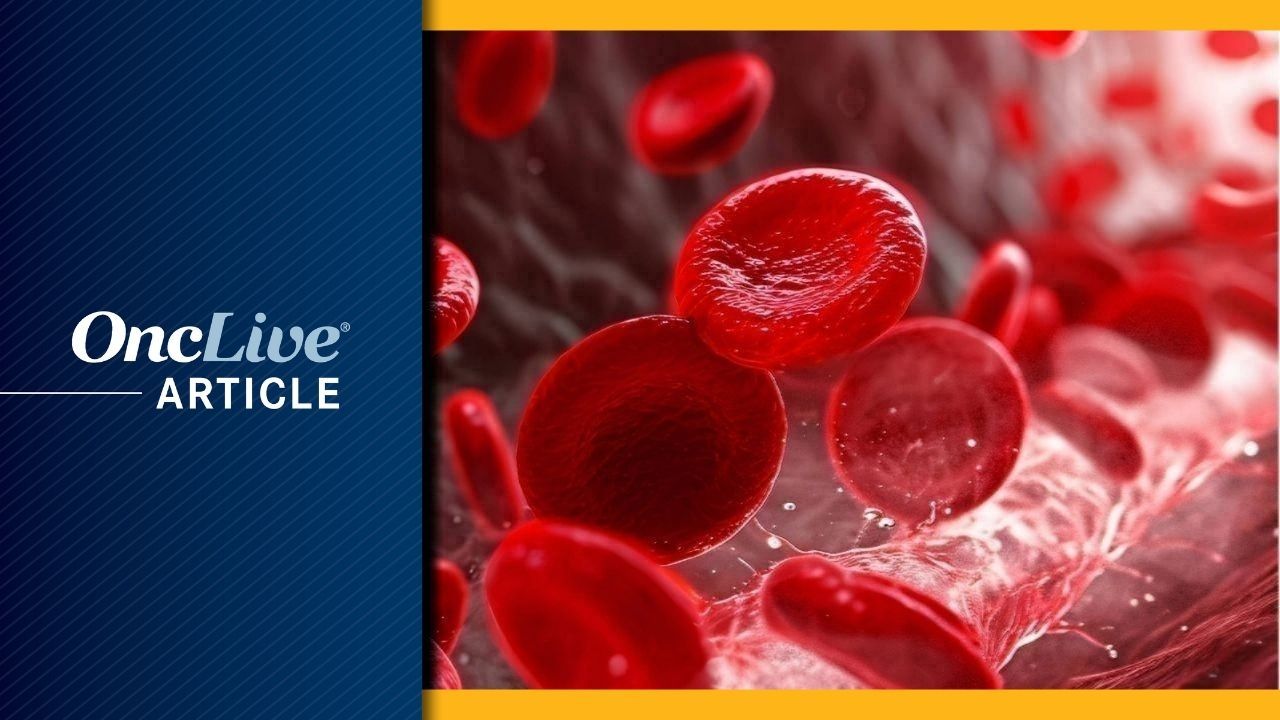Data from a meta analysis of randomized clinical trials demonstrated that treatment with JAK inhibitors was associated with improved efficacy and manageable safety compared with best available therapy (BAT) in patients with myelofibrosis.1
Findings showed that at 24 weeks, treatment with JAK inhibitors led to an improvement in the proportion of patients who experienced a spleen volume reduction of at least 35% (SVR ≥35%; OR, 5.81; 95% CI, 2.24-15.07; P < .05) and a reduction in total symptom score of at least 50% (TSS50; OR, 2.35; 95% CI, 1.28-4.32; P < .05).
“JAK inhibitors in myelofibrosis demonstrated superior efficacy over BAT, achieving meaningful clinical end points with manageable toxicities, setting a benchmark for future treatment strategies,” lead study author and hematology/oncology fellow Junaid Anwar, MD, of UTHealth in Houston, Texas, and colleagues wrote in a poster presentation of the data.
JAK Inhibitors vs BAT in Myelofibrosis: Meta Analysis
- A meta analysis showed the JAK Inhibitors ruxolitinib, fedratinib, pacritinib, and momelotinib were associated with improvements in SVR35 and TSS50 compared with BAT in myelofibrosis.
- JAK inhibition was also associated with higher rates of grade 3 or higher anemia and grade 3 or higher thrombocytopenia.
- Ruxolitinib, fedratinib, pacritinib, and momelotinib are currently approved by the FDA for select patients with myelofibrosis.
How was the meta analysis of JAK inhibitors in myelofibrosis designed?
Investigators followed Preferred Reporting Items for Systematic Reviews and Meta-Analyses guidelines to conduct systematic searches of PubMed, EMBASE, Cochrane, and ClinicalTrials.gov to pull relevant data through April 2024. The analysis included patients treated in the phase 3b Freedom trial (NCT03755518) evaluating fedratinib (Inrebic) in patients with intermediate- or high-risk myelofibrosis who had a platelet count of at least 50 × 109/L and were previously treated with ruxolitinib (Jakafi); the phase 3 Persist-2 trial (NCT02055781) investigating pacritinib (Vonjo) in patients with myelofibrosis and thrombocytopenia; the phase 3 SIMPLIFY 2 trial (NCT02101268) examining momelotinib (Ojjaara) in patients with myelofibrosis who had suboptimal response or hematological adverse effects with ruxolitinib; the phase 3 PERSIST-1 trial (NCT01773187) evaluating pacritinib in patients with myelofibrosis; and the phase 3 COMFORT-II trial (NCT00934544) investigating ruxolitinib for patients with myelofibrosis.
Notably, the JAK inhibitors ruxolitinib, fedratinib, pacritinib, and momelotinib are all currently approved by the FDA and hold indications for the treatment of select patients with myelofibrosis.2-5 Pacritinib and momelotinib are the two most recently approved JAK inhibitors for myelofibrosis, earning FDA approval in 2022 and 2023, respectively.4,5 Pacritinib is indicated for the treatment of adult patients with intermediate or high-risk primary or secondary (post-polycythemia vera or post-essential thrombocythemia) myelofibrosis with a platelet count below 50 × 109/L;4 and momelotinib is approved for the treatment of intermediate or high-risk myelofibrosis, including primary myelofibrosis or secondary myelofibrosis (post-polycythemia vera and post-essential thrombocythemia) in adult patients with anemia.5
In the analysis, investigators pooled dichotomous and continuous outcomes using RevMan 5.4 and 95% confidence intervals, and study heterogeneity was evaluated using I2 and X2 statistical tests.1 A P value of less than 0.5 was deemed statistically significant in this study.
The study’s primary end point was to evaluate SVR35 and TSS50 at 24 weeks for ruxolitinib, pacritinib, momelotinib, and fedratinib compared with BAT. Investigators also assessed safety of the JAK inhibitors vs BAT.
What were the key safety findings for JAK inhibition vs BAT in myelofibrosis?
Results also showed that JAK inhibitors were associated with statistically significant increases in the rate of grade 3 or higher anemia (risk ratio [RR], 1.30; 95% CI, 1.01-1.67; P < .05), grade 3 or higher thrombocytopenia (RR, 1.47; 95% CI, 1.05-2.04; P < .05), any-grade diarrhea (RR, 3.37; 95% CI, 1.90-5.98; P < .05), and any-grade nausea (RR, 3.12; 95% CI, 1.84-5.29; P < .05) compared with BAT.
Notably, no statistically significant differences were observed for JAK inhibitors vs BAT in regard to the rates of any-grade pyrexia (RR, 1.42; 95% CI, 0.59-3.41), any-grade fatigue (RR, 1.04; 95% CI, 0.74-1.46), and any-grade peripheral edema (RR, 0.84; 95% CI, 0.62-1.15).
References
- Anwar J, Ijaz H, Saif P, et al. JAK inhibitors vs best available therapy for myelofibrosis; a meta-analysis of randomized clinical trials. Presented at: 2025 SOHO Annual Meeting; September 3-6, 2025; Hoston, TX. Abstract MPN-612.
- Jakafi. Prescribing information. Incyte; 2023. Accessed November 3, 2025. https://www.jakafi.com/jakafi-prescribing-information
- Inrebic. Prescribing information. Bristol Myers Squibb; 2025. Accessed November 3, 2025. https://packageinserts.bms.com/pi/pi_inrebic.pdf
- Vonjo. Prescribing information. Sobi; 2025. Accessed November 3, 2025. https://www.vonjohcp.com/sites/default/files/2024-09/prescribing-information.pdf
- Ojjaara. Prescribing information. GlaxoSmithKline; 2025. Accessed November 3, 2025. https://gskpro.com/content/dam/global/hcpportal/en_US/Prescribing_Information/Ojjaara/pdf/OJJAARA-PI-PIL.PDF
